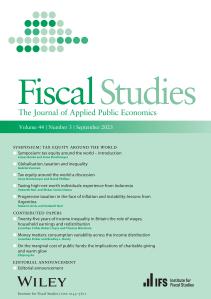We’ve got so used to economic forecasts moving between fiscal events as economic shocks hit us from all directions, that it was almost a surprise, and something of a relief, that the Office for Budget Responsibility didn’t make any big changes to its forecasts relative to November. That’s how it should be over such a short period.
The problem for the chancellor was that he had used up nearly all his fiscal headroom at the autumn statement so, without a decisive improvement in forecasts, he was left with very little room for manoeuvre. So, this may have been a pre-election budget, but it was one where the constraints on action were severe.
You can see that in what was announced. The £10 billion cut in national insurance was the only substantial giveaway, and it was part paid for by a slew of minor tax increases plus a further cut in that fiscal headroom. We called it wafer thin last time. It’s now thinner than wafer thin, gossamer thin perhaps.
And poor old Jeremy Hunt. On his figures he is getting borrowing down to historically low levels, but that’s still not enough to get debt on a properly downward path.
His problem is that high debt and poor growth make that much more difficult than it used to be. He is also still facing close to record debt interest payments, which mean that he has to plan to run a substantial primary surplus — that is raise more in tax and other revenues than he spends on everything other than debt interest — just to hold debt steady. Taking more from us than he gives back in spending on services and benefits is not a recipe for a happy electorate.
We can spend a long time examining the minutiae of the fiscal rules, but those are the fiscal realities. We are in an historically very tough place when it comes to getting the public finances onto a sustainable footing.
Even to get debt just about stabilising in the spreadsheets we have had the usual nonsense around fuel duties. To absolutely nobody’s surprise they were frozen for the 15th year in a row, yet the public finance numbers continue to assume they won’t be frozen from now on. And the public spending numbers continue to assume sharp cuts in overall investment spending and cuts in day-to-day spending for a range of public services. The chancellor has not told us where those cuts will fall.
He’s not going to tell us either. Hidden away on page 35 of the budget red book is an announcement that the next spending review won’t come until after the election. That is not going to give much notice to any public services of what their budget will be from April 2025. I am sure it also means we won’t be told where the spending axe is supposed to be falling.
One thing is for certain. Whoever is chancellor after the next election, they are going to have one heck of a difficult circle to square. They will inherit historically high taxes, struggling public services, a big debt interest bill, the highest debt in 60 years, and poor growth. The first post-election budget and spending review will contain some nasty surprises.
This article was first published in The Times, and is reproduced here with kind permission.








